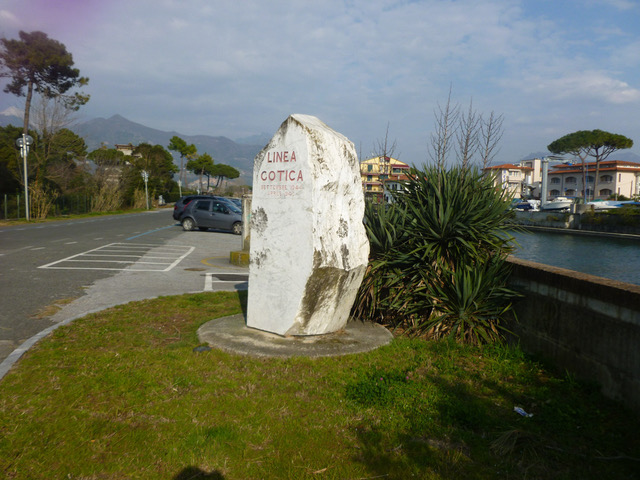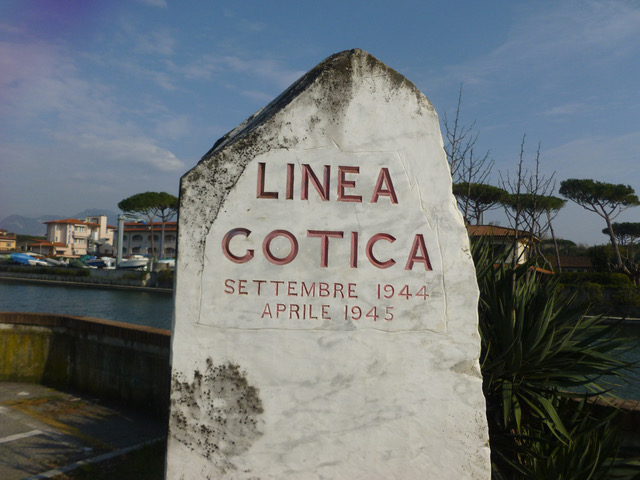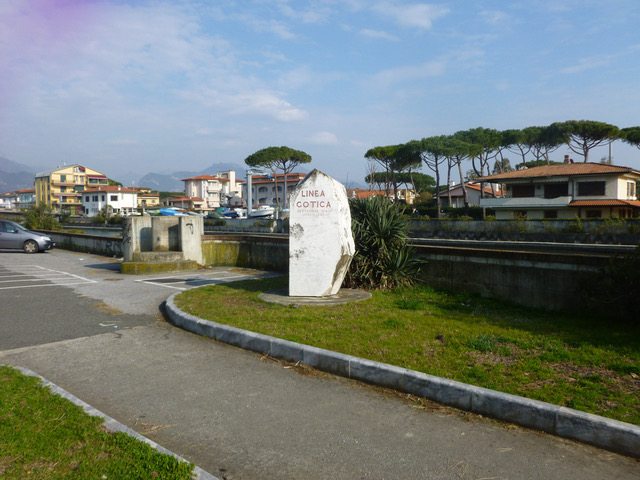Gothic Line (Linea Gotica) – Western Terminus Marker
Details:
The marker is located on the bank of the Versilia River and is next to a large marble monument to the Partisan/Resistance Movement in Italy during World War 2.
A white inscribed stone standing about 5 feet high sitting on a cement base.
The marker delimits the western terminus of the Gothic Line (Linea Gotica); the German defensive line across the Apennines mountains occupied in late 1944 to April 1945.
Something about the Gothic Line: The last major line of defense in the final stages of World War II, along the Apennines formed by Field Marshal Albert Kesselring, was named “Gothic Line" (Gotenstellung). During the Summer of 1944, when it was feared the Allied armies would easily breach it and fan out in the Po Valley after their advance North of Rome, the name was changed by Kesselring to “Green Line” (Grüne Linie), so as not to compromise such an imposing denomination, but the first name survived in general parlance.
The tactics of retreating to organized lines of defense prepared along prominent terrain features up the Italian “boot” (such as the "Gustav Line" at Cassino) was successfully followed by the German Army throughout the Italian Campaign. The German command had started to study the idea of fortifying the Central Apennines already in August 1943, when the Allies were still fighting in Sicily. Work however started only during the Spring of 1944, under the direction of the Todt work organization.
The Gothic Line was not a continuous line of fortification, but rather a series of strong points arranged in depth, exploiting the natural terrain features which favored the defender. Traversing the Italian mainland from the Tyrrhenian coast North of Viareggio to the Adriatic at Pesaro, the line extended for more than 300 km. It included thousands of field fortifications made of wood, rock or steel-girded concrete, and included long antitank ditches - extended mine fields and wire emplacements completed the picture.
The 92nd Infantry Division "Buffalo Soldiers": The US 92nd Division (African-American unit) with the attached 442nd Regimental Combat team (Japanese-American Unit) fought through this area in 1944/45. 2LT Vernon Baker of the 370th Infantry Regiment, 92nd Infantry Division was awarded the Medal of Honor for his bravery and action under fire near this point in 1945. PVT Joe Hayashi of the 442nd Regimental Combat Team, was also awarded the Medal of Honor for his bravery near this site in April 1945.
Monument Text:
The text on the marker is written in Italian and reads:
LINEA GOTICA
SETTEMBRE 1944
APRILE 1945
The translation in English is:
Gothic Line
September 1944
April 1945
Commemorates:
People:
Units:
365th Infantry Regiment, 92nd Infantry Division
366th Infantry Regiment, 92nd Infantry Division
370th Infantry Regiment, 92nd Infantry Division
371st Infantry Regiment, 92nd Infantry Division
442nd Regimental Combat Team
5th Army
92nd Infantry Division
Wars:
WWII
Battles:
Gothic Line
Italian Campaign
Other images :






